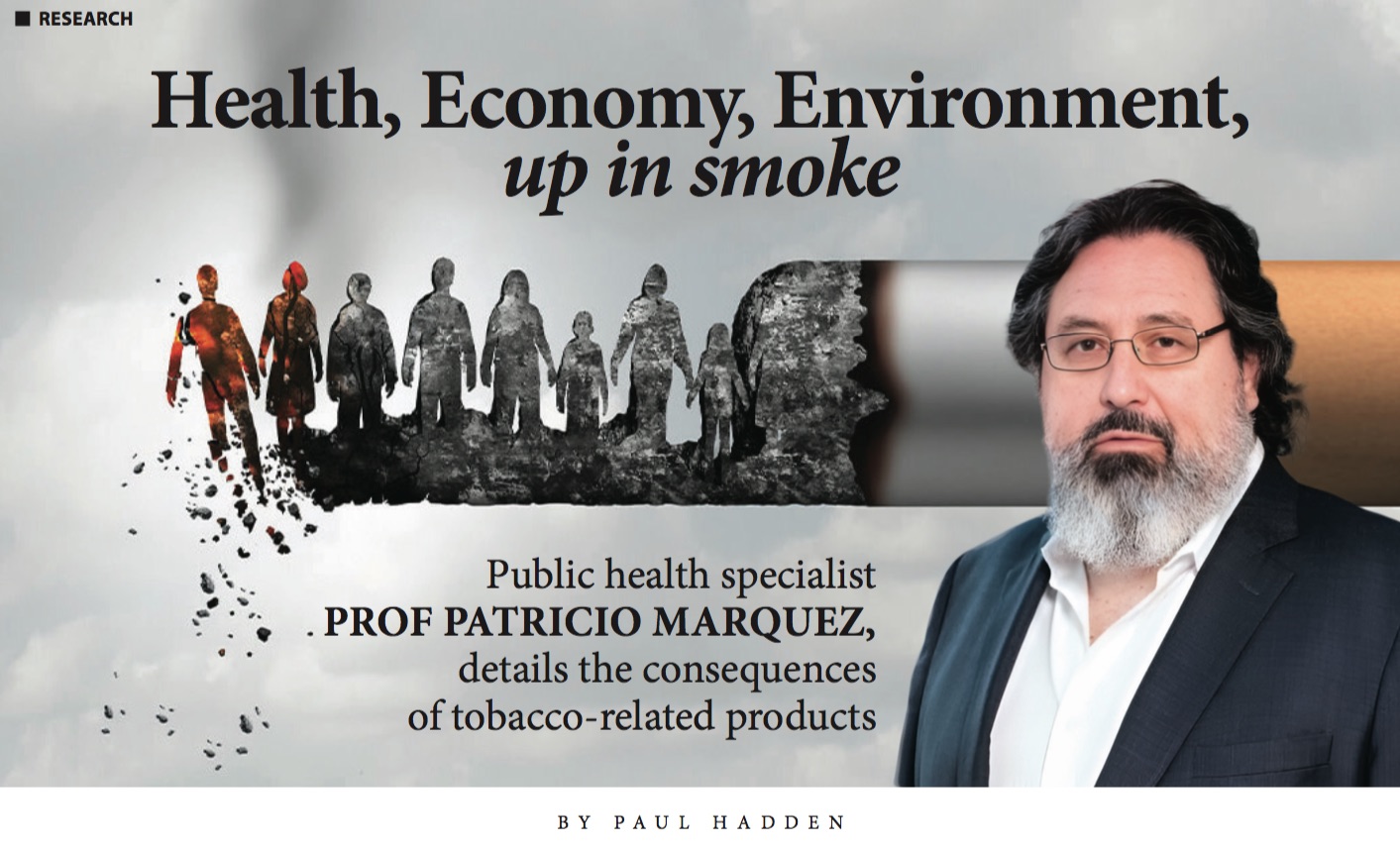
“Tobacco is a legal product that kills,” says Professor Patricio V Marquez, former Lead Public Health Specialist for the World Bank Group, Honorary Professor at The UWI, and fierce anti-tobacco advocate.
That tobacco is a deadly product should come as no surprise to anyone living in our modern era, yet the sobering statistics surrounding current tobacco use presented by Professor Marquez during a recent interview serve as a stark reminder that the battle against smoking is far from over.
Although there has been a significant reduction in smoking over the last few decades, Professor Marquez explains that current data indicates that around one-in-four adults in the world smoke tobacco. The total number of smokers remains high due to population growth.
Globally, there are 1.3 billion tobacco users aged 15 or older. More than 75 percent of male daily smokers live in a country with a medium or high human development index (HDI), whereas more than 53 percent of female daily smokers live in very high-HDI countries. In the Caribbean region, smoking rates stood at 16.3 percent of the adult population in 2020.
These are worrying statistics,” adds Mrs Haleema Ali-Sisbane, economist at the UWI's HEU, Centre for Health Economics, “that warrant immediate intervention.”
The discussion between Professor Marquez and Mrs Ali-Sisbane took place during a recent discussion on the dangers of tobacco for health and the economy hosted by the HEU. The virtual event was organised in recognition of the World Health Organisation's World No-Tobacco Day, which raises awareness of the harmful and deadly effects of tobacco use, and draws attention to what many consider the questionable business practices of tobacco companies.
Professor Marquez is no stranger to advocating for public health issues, and has more than 35 years of experience in the field which have been spent working in over 80 countries. He also served as a Pledge Champion for the Tobacco-Free Portfolios Pledge Initiative.
Much of the current tobacco use, argues Professor Marquez, can be linked to the influential power of the advertising industry where, in the United States alone, a whopping US$8.2 billion is spent annually on advertising tobacco-related products, including e-cigarettes.
He notes that many of these advertisements deliberately target specific vulnerable populations including the youth, young adults, and minority groups.
“The manipulation and deception that take place in the marketplace through advertisements influence decisions to use tobacco,” he says, “and by promoting the glamourous side of these products, by promoting feel good types of messages, and by sharing the message that ‘harm-reduction’ products are good for the youth, adolescents become users of these products.”
This, he explains, initiates a life-long addiction that “harms health and also carries other negative and social consequences”.
His view of the tobacco industry stands in stark contrast to the apparent change of heart that major tobacco companies seem to have taken in recent years, with many now declaring that their new mission is to “unsmoke the world”.
However, Professor Marquez notes that, “There is much skepticism about this claim. The history of the tobacco industry provides ample evidence for skepticism, if not outright rejection.”
At a time when many believe that tobacco smoking is on its way out, and where many wealthier nations have put measures in place to mitigate its use, he cautions that cigarettes are still being widely promoted and sold in low and middle income countries where fewer regulations and lower taxes make cigarettes and other tobacco-related products easily accessible to the general public.
In response to Mrs Ali-Sisbane's question regarding the environmental cost of tobacco farming, Professor Marquez had this to say, “Nowadays, the devastating public health consequences of tobacco use are widely understood and documented, yet few people appreciate that tobacco also has a profoundly negative impact on the environment.”
Cigarette filters (made of cellulose acetate), for example, constitute the number one ocean plastic, more numerous than plastic bottles, bags, or straws. Disposing of e-cigarette cartridges, that contain plastic, electronic and chemical waste, is a growing problem. Regarding the farming of tobacco, Professor Marquez notes its environmental impact includes degradation of soil quality, deforestation due to land clearing to grow the crops and procure wood for tobacco curing, improper disposal of containers, runoff of pesticides and other chemicals that pollute the water supply sources of entire communities, and the generation of carbon emissions.
“When it comes to carbon emissions,” he says, “tobacco has a similar footprint to entire countries.”
More than just a re-hashing of the facts, the virtual discussion between Mrs Ali-Sisbane and Professor Marquez stands as a call-to-action to end tobacco use in all its forms, including the so-called “safe products” on the market which include vaping products.
Professor Marquez insists that the alarming statistics delivered during the discussion should serve as a wake-up call to continue the fight against tobacco use.
“The evidence is clear and should concern all of us,” he says, “all of us have a role to play by raising our voices and by promoting and disseminating information about the public health issues, the environmental degradation, and the high economic costs of tobacco use. At the end of the day, there is a societal cost that all of us are paying for.”